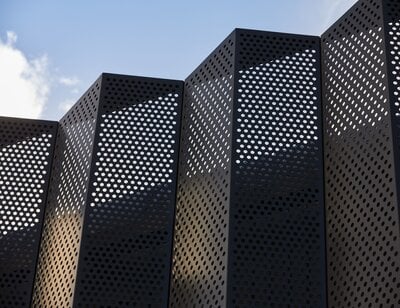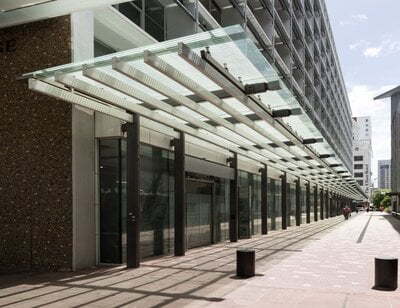The notion of a building being able to power itself might seem absurd. After all, buildings account for 30-40% of all energy consumption and that's a lot of energy. However, they also account for around the same percentage of all carbon emissions. And that's a lot of emissions. So the notion of reducing both, whilst seemingly absurd and far-fetched, is not without considerable appeal. It might not be that far-fetched either.
The need for self-sustaining buildings goes beyond the obvious too. As New Zealand transitions to an electric fleet, with ICE vehicles being phased out, there will be new demands on the national grid. Infometrics suggests by 2023 there'll be a need for additional capacity. However, they also assume the off-peak charging of vehicles, which won't be the case in all circumstances simply because there'll always be a need to charge during the day for some users. Besides which, it's not uncommon for the firs to reach capacity during winter now. So any additional burden from the move to EV's might well need to be balanced, not only by extra grid capacity but also through energy savings. Self-sustaining buildings could play a large role in that.
But is it really possible?
Norway & the Powerhouse
A location that experiences some of the coldest and darkest winders on earth makes for an ideal test location. If a self-sufficient building can be made to work in Norway, then it should certainly be possible to building one in Bluff. Which is precisely why Project Powerhouse was started in 2010. A collaboration between multiple parties, including architects, it calls itself the most climate-ambitious player in the construction sector. It might be right to.
Their first completed project was Powerhouse Kjorbo. A renovated office block, iit has the capacity to produce around 230,000 kWh per year from solar panels, making it the first commercial building in the world to generate more energy than it consumes.
Project Brattakaia is the collaboration's latest building. it's able to generate more than twice as much energy as it consumes, with quite astounding self-0generating capacity of 485,000 kWh per year. That's enough for almost 70 kiwi homes for a year.
It's all very impressive but so was the Martin Jetpack. As they found out, bringing something to market is completely different from proving an idea flies (pun intended). There is no ready mention of the cost of the Powerhouse Projects and it would be reasonable to assume they might not commercially viable for your average developer.
So where does that leave us? Just outside Boston probably. Situated near the Harvard campus in Massachuetts, is HouseZero. It’s been described as a model for the future, using almost zero energy for heating and cooling. It's more modest that the Powerhouse Projects by maybe it could provide a solution which is more appropriate for widespread adoption? It would seem not if this article is anything to go by. There's no mention of the cost of the conversion and there are some fundamental flaws in the calculations used to support the model.
So maybe a building cannot power itself. However, Einstein is on recording as saying in 1934 that 'there is not the slightest indication that Nuclear Energy will ever be attainable.' If Albert could be proven wrong then we're optimistic someone will perfect the design for a self-sufficient building that is also commercially viable.
Harnessing Energy from the Sun
Both the Powerhouse projects and HouseZero use solar panels as the primary source of energy generation. That in itself is nothing new. Indeed, the earliest observation of the Photovoltaic effect dates back to 1839, although it wasn't until April 1954 when the first practical solar cell was developed by researchers at Bell Laboratories. That’s the best part of a century ago and solar power has never really taken off. A little over 1% of NZ houses and businesses have solar panels installed and uptake remains slow. That might change if Tesla can successfully push their solar house tiles to more people, assuming the price is not prohibitive.
For commercial buildings, there is limited roof space for solar panels (or Tesla style tiles) and they can look less than aesthetically desirable if plastered down the sides. But what about a paint that can create electricity?
A school gym in Almere, Netherlands, is coated in a special green paint. This paint helps the panels absorb sunlight, converting the energy into electricity used to power a heat pump for heating or cooling. It's one example of what's known as 'Solar Paint'.
There are several different variations of solar paint. Scientists from the Royal Melbourne Institute of Technology (RMIT) have developed a solar paint containing titanium oxide with a new compound synthetic molybdenum-sulphide. This paint is unique in that it not only uses sunlight but can also absorb moisture vapour from the air, splitting the atoms into hydrogen and oxygen. The harvested hydrogen can then be used as fuel. The researchers believe the paint will have multiple applications, including use on walls, fences and sheds, effectively turning each into an energy harvesting structure.
Meanwhile, the University of Toronto has been busy developing Quantum Dot Solar Cells. Nanoscale semiconductors are embedded a photon absorbing film, which, in theory, can be sprayed on pretty much anything. That includes an aeroplane wing or a car roof. Indeed, they believe spraying the roof of your car would be good enough to generate enough electricity to power 24 compact fluorescent lights.
That sounds pretty good. As does Perovskite Solar Paint, developed by the University of Sheffield. They've managed to develop a liquid form of Perovskite crystal structures (named after Leo Perovski's discovery in the Ural Mountains in 1939) which can be spray painted onto a surface.
All of the above have common advantages. Namely, the ability to turn almost any surface into an energy harvesting device. However, they all suffer from the same disadvantage. Solar Paint is not very efficient and only captures up to 8% of solar energy.
There's also the issue of commercialisation. As with the building examples in Norway and the USA, the theory might be find but practical implementation for everyday projects is not likely anytime soon.
Piezoelectric Facades
If harnessing the sun is not yet commercially viable for powering a building, then what about somehow transforming any mechanical strain and vibration into electricity?
Piezoelectric facades seek to do just that. They use the swaying motion from elements buffered by the wind, using the movement to generate electricity. One of the most striking examples was the proposal to cover a skyscraper in Stockholm in thousands of electricity generating bristles (or plastic straws). It did give the building a certain woolly mammoth style aesthetic though.
Yet there is something here. If we could harness the wind in Wellington to generate electricity we truly would be making the most of a natural resource, turning a perceived problem of Wellington life into a major positive. Wind power is also typically more efficient than solar power, harnessing around 60% of the energy that passes through them vs the 20% or so harnessed by solar panels.
Back to the original question - could a facade power a building? Theoretically the answer has to be yes. But maybe we're asking the wrong question? Maybe we should be asking - can a facade help power a building? The answer to that has to be yes. There are still some practical considerations and a solution has to be commercially viable, yet we have to believe we're not too far away. That's pretty exciting.








